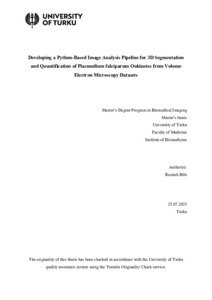Developing a Python-Based Image Analysis Pipeline for 3D Segmentation and Quantification of Plasmodium falciparum Ookinetes from Volume Electron Microscopy Datasets
Bibi, Ramish (2025-07-30)
Developing a Python-Based Image Analysis Pipeline for 3D Segmentation and Quantification of Plasmodium falciparum Ookinetes from Volume Electron Microscopy Datasets
Bibi, Ramish
(30.07.2025)
Julkaisu on tekijänoikeussäännösten alainen. Teosta voi lukea ja tulostaa henkilökohtaista käyttöä varten. Käyttö kaupallisiin tarkoituksiin on kielletty.
avoin
Julkaisun pysyvä osoite on:
https://urn.fi/URN:NBN:fi-fe20251020102274
https://urn.fi/URN:NBN:fi-fe20251020102274
Tiivistelmä
Understanding the complex 3D organization of Plasmodium falciparum ookinetes is essential for uncovering how these malaria-causing parasites develop and invade their mosquito hosts. This thesis presents a practical and semi-automated image analysis pipeline designed to extract meaningful biological information from large-scale volumetric electron microscopy (EM) datasets of ookinetes. The pipeline was developed in Python and orchestrated using the workflow management tool Nextflow. It was designed to handle the challenges posed by large-sized raw tiled images, and image artifacts commonly found in volumetric EM data.
The analysis pipeline begins with automated tile stitching, producing complete 3D image stacks from raw TIFF mosaics. These stitched volumes are converted to the efficient next-generation file format OME-Zarr, which enables reduced storage, faster visualization, and accessibility. To facilitate downstream processing, parasite-containing regions are isolated through automatic volume cropping, followed by semi-automated image registration to align z-slices.
A key focus of this study is on 3D segmentation of ookinetes and their ultrastructural organelles including micronemes, hemozoin crystals, nuclei, and crystalloids. Initial attempts to use Meta AI’s Segment Anything Model (SAM) directly on EM images were unsuccessful due to its limited performance in low-contrast biological images. Instead, segmentation was successfully performed using Napari-based tools (napari-SAM and napari-SAMv2), which combine SAM’s strengths with user-guided annotation to produce accurate 3D masks.
From these segmented volumes, a series of organelle-level quantifications were carried out, including measurements of count, volume, and spatial distribution of micronemes, crystalloids and hemozoin crystals. The final output of the pipeline is a set of structured CSV files that biologists can use to explore developmental stage specific differences and gain insight into parasite biology. While this thesis does not attempt to draw statistical or biological conclusions, it establishes a robust computational framework for future expert-led biological interpretation and discovery.
In summary, this work demonstrates a scalable, semi-automated solution to process challenging 3D EM datasets from raw image tiles to quantifiable biological features providing a strong foundation for future studies into the cell biology of Plasmodium parasites.
The analysis pipeline begins with automated tile stitching, producing complete 3D image stacks from raw TIFF mosaics. These stitched volumes are converted to the efficient next-generation file format OME-Zarr, which enables reduced storage, faster visualization, and accessibility. To facilitate downstream processing, parasite-containing regions are isolated through automatic volume cropping, followed by semi-automated image registration to align z-slices.
A key focus of this study is on 3D segmentation of ookinetes and their ultrastructural organelles including micronemes, hemozoin crystals, nuclei, and crystalloids. Initial attempts to use Meta AI’s Segment Anything Model (SAM) directly on EM images were unsuccessful due to its limited performance in low-contrast biological images. Instead, segmentation was successfully performed using Napari-based tools (napari-SAM and napari-SAMv2), which combine SAM’s strengths with user-guided annotation to produce accurate 3D masks.
From these segmented volumes, a series of organelle-level quantifications were carried out, including measurements of count, volume, and spatial distribution of micronemes, crystalloids and hemozoin crystals. The final output of the pipeline is a set of structured CSV files that biologists can use to explore developmental stage specific differences and gain insight into parasite biology. While this thesis does not attempt to draw statistical or biological conclusions, it establishes a robust computational framework for future expert-led biological interpretation and discovery.
In summary, this work demonstrates a scalable, semi-automated solution to process challenging 3D EM datasets from raw image tiles to quantifiable biological features providing a strong foundation for future studies into the cell biology of Plasmodium parasites.
